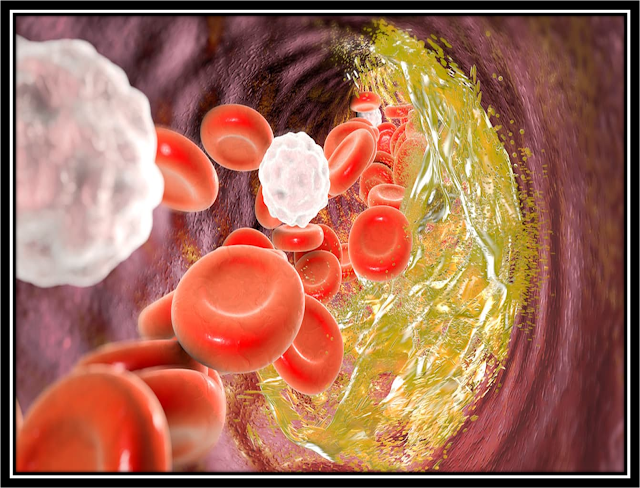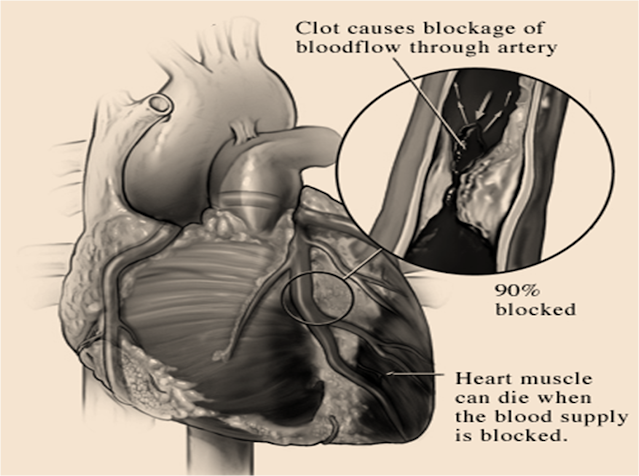Nutrition therapy for Atherosclerosis:
- In general nutrition therapy effect as by
- interfering with plaque formation by
- inhibiting the inflammatory response.
- Physiological changes with in the blood vessels
- Focus should be on the cumulative effect of the entire diet as well as other lifestyle factors when planning dietary changes as in TLC.
Nutrition assessment:
Nutrition technology is likely to be present in patient with CAD are the following:
- Excessive energy intake
- Excessive fat intake
- Physical inactivity
- Overweight / obesity ,
- Inadequate fiber intake ,
- Inadequate vitamin intake,
- Undesirable food choices,
- Food and nutrition- related knowledge deficit
- Inadequate bioactive substances intake (plants sterols,)
- In appropriate intake of ( saturated fat, trans fats, cholesterol,)
- Inadequate intake of fats types ( monounsaturated fat, Omega 3 fatty acids,)
Physical activity:
- Patients who experience angina or who are post MI and or post-operative should participate in medically supervised exercise program, commonly referred to as cardiac rehabilitation.
- Cardiac rehabilitation is designed to improve functional capacity while controlling risk factor in order to improve outcomes.
Total dietary fat:
- Maintain of dietary fat intake with in 20% to 35% of total caloric intake.
- Fat that is consumed as a part of the normal diet is a mixture of saturated, polyunsaturated and monounsaturated fatty acids.
- For example, olive oil is consumed primarily of monounsaturated fat but also contain lesser amount of saturated and polyunsaturated fat.
- The specific type of fat that is consumed has been the emphasis for research in nutrition and cardiovascular diseases for the previous five decades.
- Current guideline in emphasis reducing amount of saturated and trans fatty acids rather than a strict adherence to a reduced fat - diet.
- Very low- fat diet combined with other lifestyle modification such as increased physical activity and smoking cessation appear to have the most dramatic results in reducing cardiovascular risk factors.
Saturated fat:
- No more than 7% of total kcal should be from saturated fat sources.
Trans fatty acids:
- An increased amount of trans fatty acid is associated with an increased risk of myocardial infarction.
- Furthermore, trans fatty acid appear to be associated with an increased inflammatory response that may contribute to the atherogenic process.
- Current recommendation for at consume less than 1% of energy from trans fat.
Monounsaturated fat:
- Intake of monounsaturated fats are related to cardiovascular diseases they affect serum lipid levels positively.
- Specifically, mono unsaturated fatty acid intake appeared to lower LDL while having no effect on HDL levels.
(Omega-3) fatty Acids: Linolenic Acid ;
- Fatty acids-eicosatetraenoic Acid (EPA) and docosahexaenoic acid (DHA)-are considered conditionally essential fatty acid because their synthesis is dependent on adequate amount of Linolenic Acid.
- EPA, is a 20 - carbon fatty acid that is a precursor of the important eicosanoid.
- Eicosanoids include families of substances called thromboxane's, prostaglandins and leukotrienes.
- EPA, therefore, is important in cellular processes, vasoconstriction, vasodilation, platelet function, immune system response and inflammatory response.
- The AHA recommends that patients with CHD consume 1g of EPA and DHA daily.
Polyunsaturated fatty acids:
- Primarily n -6 linoleic acid, which is an essential fatty acid.
- Polyunsaturated fat source are oils from vegetables such as corn 🌽, cotton seed, soybean, safflower and sunflowers oils.
- Substituted for saturated fatty acids, polyunsaturated fatty acids have been linked to a reduction of LDL and are associated with decreased cardiovascular disease risk.
Cholesterol:
- Not of much concern today
- Total daily cholesterol absorption and synthesis is approximately 1000 mg per day.
- The rate-limiting step in synthesis involves the enzyme HMG CoA, reductase, which has been a target for pharmaceutical and intervention in treating hypercholesterolemia through the use of statin medications.
- The national cholesterol education program currently recommends and intake of less than 200 mg per day.
Fiber:
- Intake of soluble fiber in cardiovascular diseases are based on its ability to reduce LDL and total serum cholesterol levels.
- Dietary fiber is defined as'' Nondigestible carbohydrates and lignin that are intact and intrinsic in plants.
- Functional fiber is defined as '' Nondigestible carbohydrates that have been isolated extracted or manufactured and have beneficial physiological effects in humans''
- Soluble viscous fiber may reduce serum cholesterol and LDL level in several ways.
- First, soluble fiber may decrease or absorption of lipids.
- Secondly soluble fiber is thought to bind bile acids and increased their excretion
- rather than allow to enter intrahepatic circulation.
- This excretion decrease the overall body pool of cholesterol.
- Finally, in response to the decreasing amount of cholesterol, the body transfers low-
- density lipoproteins LDL and the cholesterol they contain to the liver to support the increased synthesis of bile.
- The US dietary guidelines recommend consuming 14g of fiber for every 1000kcal.
Nuts:
- The consumption of nuts has been correlated with the reduced cardiac risk.
- This may be due to their specific lipid composition (high -ALA, low saturated fat ,high unsaturated fat).
- When substituted for animal protein, they may favorably improve the overall nutrient content of the diet.
- Recommendation is to consume unto 1 dose of unsalted nuts as a substitution for equivalent and energy from higher saturated fat food source in the diet.
Plants /Sterols(Phytosterols):
- Plants do not contain cholesterol but they do have similar sterol components.
- There are over 60 different type of plants but the most common is a sitosterol.
- Humans do not synthesize these sterols, as the they do cholesterol, nor are they well absorbed..
- Research has demonstrated that when these plant sterols are esterified to common fatty acid (stanol ester or sterile ester),they can assist in lowering serum cholesterol and LDL levels.
- Plants Sterols inhibit lipid absorption at the micelle, which reduces dietary and biliary cholesterol absorption.
How to manage atherosclerosis with diet?
Which kind of fat are best for atherosclerosis?
How physical activity effect atherosclerosis?






No comments
Please do not enter spam link in the comment box